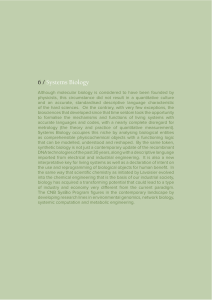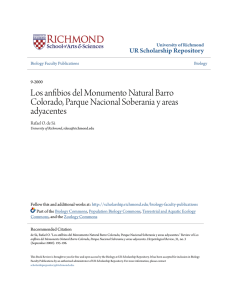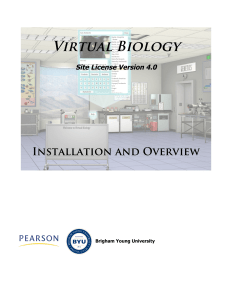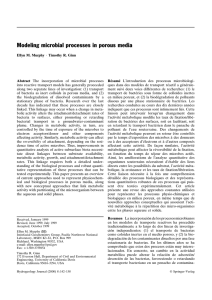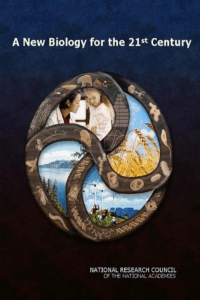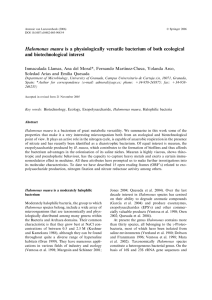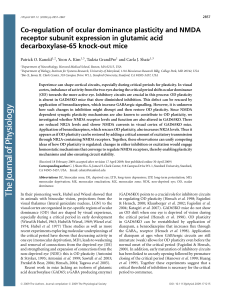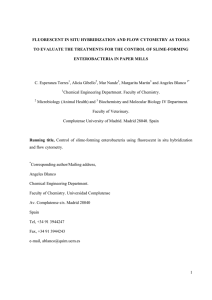06Systems Biology
Anuncio
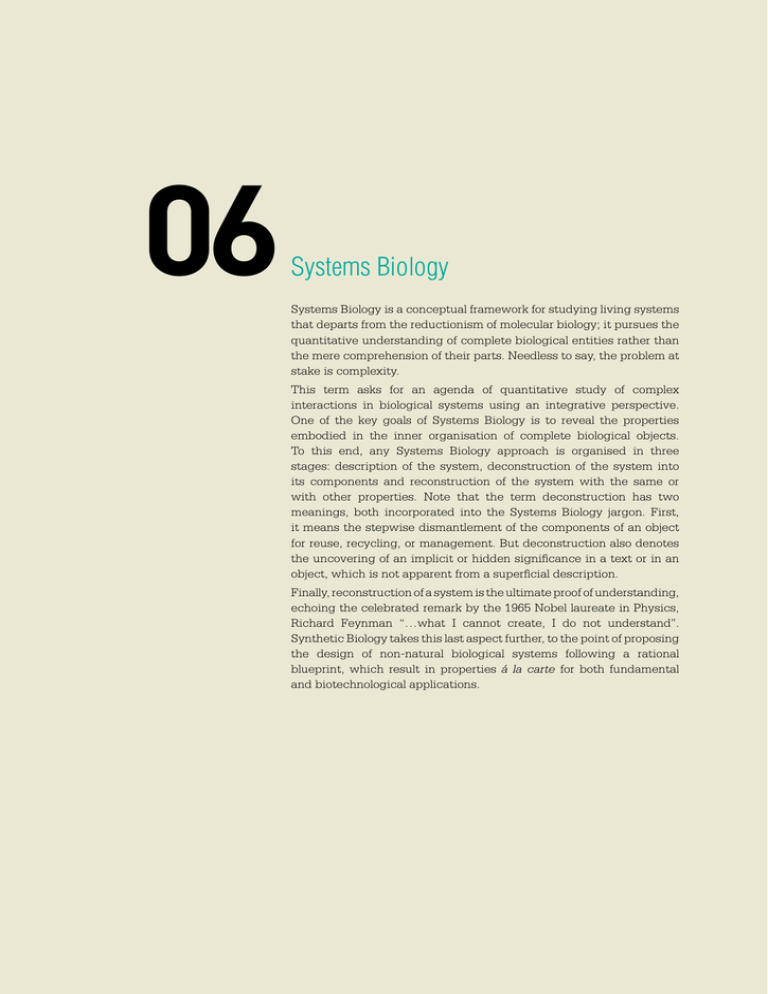
06 Systems Biology Systems Biology is a conceptual framework for studying living systems that departs from the reductionism of molecular biology; it pursues the quantitative understanding of complete biological entities rather than the mere comprehension of their parts. Needless to say, the problem at stake is complexity. This term asks for an agenda of quantitative study of complex interactions in biological systems using an integrative perspective. One of the key goals of Systems Biology is to reveal the properties embodied in the inner organisation of complete biological objects. To this end, any Systems Biology approach is organised in three stages: description of the system, deconstruction of the system into its components and reconstruction of the system with the same or with other properties. Note that the term deconstruction has two meanings, both incorporated into the Systems Biology jargon. First, it means the stepwise dismantlement of the components of an object for reuse, recycling, or management. But deconstruction also denotes the uncovering of an implicit or hidden significance in a text or in an object, which is not apparent from a superficial description. Finally, reconstruction of a system is the ultimate proof of understanding, echoing the celebrated remark by the 1965 Nobel laureate in Physics, Richard Feynman “…what I cannot create, I do not understand”. Synthetic Biology takes this last aspect further, to the point of proposing the design of non-natural biological systems following a rational blueprint, which result in properties á la carte for both fundamental and biotechnological applications. GROUP LEADER: Víctor de Lorenzo POSTDOCTORAL SCIENTISTS: PHD STUDENTS: Belén Calles Ilaria Benedetti Esteban Martínez Juhyun Kim Pablo I. Nikel Alberto Sánchez-Pascuala Danilo Pérez Angel Goñi Master’s degree student: Özlem Akkaya Mª Angeles Hueso TECHNICIANS: Sofía Fraile Tomás Aparicio Administrative assistant: Inés Merino Visiting scientist: Nanna Svenningsen 88 Systems Biology / 2011-2012 REPORT ........................................................................................................................................................................................................................................................................................................... Molecular environmental microbiology SELECTED PUBLICATIONS de Las Heras A, Fraile S, de Lorenzo V. Increasing signal specificity of the TOL network of Pseudomonas putida mt-2 by rewiring the connectivity of the master regulator XylR. PLoS Genet. 2012;8(10):e1002963 Valls M, Silva-Rocha R, Cases I, Muñoz A, de Lorenzo V. Functional analysis of the integration host factor site of the σ54 Pu promoter of Pseudomonas putida by in vivo UV imprinting. Mol Microbiol. 2011 Nov;82(3):591-601 de Las Heras A, Chavarría M, de Lorenzo V. Association of dnt genes of Burkholderia sp. DNT with the substrate-blind regulator DntR draws the evolutionary itinerary of 2,4-dinitrotoluene biodegradation. Mol Microbiol. 2011 Oct;82(2):287-99 Silva-Rocha R, Tamames J, dos Santos VM, de Lorenzo V. The logicome of environmental bacteria: merging catabolic and regulatory events with Boolean formalisms. Environ Microbiol. 2011 Sep;13(9):2389-402 Chavarría M, Santiago C, Platero R, Krell T, Casasnovas JM, de Lorenzo V. Fructose 1-phosphate is the preferred effector of the metabolic regulator Cra of Pseudomonas putida. J Biol Chem. 2011 Mar 18;286(11):9351-9 1 Our research efforts attempt to understand how bacteria that inhabit natural niches sense and process multiple environmental signals into distinct transcriptional and post-transcriptional responses –both at the level of single cells and as a community. Unlike laboratory settings, in which growth conditions can be controlled and changed one at a time, bacteria in the environment must perpetually make gene expression decisions between activating metabolic genes for available, frequently mixed carbon sources, and those for escaping or adapting to physico-chemical stress. Our preferred experimental system involves the KT2440 strain of the soil and plant root coloniser Pseudomonas putida bearing the plasmid pWW0, which allows growth on toluene and m-xylene as the only C and energy source. The biotechnological side of this biological question is the possibility of programming bacteria for deliberate environmental release, aimed at biodegradation of toxic pollutants or as biosensors to monitor the presence of given chemicals. Apart from understanding and developing such sensor or catalytic bacteria, their release requires the GMO to be endowed with a high degree of containment and predictability. Our research is committed to developing novel molecular tools for the genetic analysis and construction of soil microorganisms destined for the environment or as catalysts for selected biotransformations. We have increasingly adopted conceptual and material tools that stem from contemporary systems and synthetic biology to address outstanding environmental pollution problems. During the last two years, we have made considerable progress toward establishing rules for the physical assembly of biological devices to be implanted in bacteria that are then deployed in environmental and industrial settings. The use of standard descriptive languages and genetic tools has enabled us to model regulatory networks of P. putida as sets of digital, Boolean logic gates similar to those employed in electric engineering. These models reveal the inner raison d’être of extant network architectures. In a subsequent step, we were able to redesign such logic circuits to increase their sensitivity and specificity to a suite of chemical effectors, for example, to improve the performance of biosensors. These developments pave the way toward engineering complex circuits that program bacteria to display new-to-nature properties. 2 1 Electron microscopy of frozen culture media with P. putida 2 Production of external polymeric substances by P. putida (wt, left) lacking the flagella (right) GROUP LEADER: Florencio Pazos Cabaleiro Senior scientist: Mónica Chagoyen Quiles PHD STUDENTS: Daniel López López David Ochoa García Natalia Pietrosemol TECHNICIAN: Juan Carlos Sánchez Ferrero VISITING SCIENTIST: David San León Granado 89 ......................................................................................................................................................................................................................................................................................................... Systems Biology / 2011-2012 REPORT SELECTED PUBLICATIONS Muth T, García-Martín JA, Rausell A, Juan D, Valencia A, Pazos F. JDet: interactive calculation and visualization of functionrelated conservation patterns in multiple sequence alignments and structures. Bioinformatics. 2012 Feb 15;28(4):584-6 Chagoyen M, Pazos F. Tools for the functional interpretation of metabolomic experiments. Brief Bioinform. 2012 Oct 14 Herman D, Ochoa D, Juan D, Lopez D, Valencia A, Pazos F. Selection of organisms for the co-evolution-based study of protein interactions. BMC Bioinformatics. 2011 Sep 12;12:363 Wass MN, Fuentes G, Pons C, Pazos F, Valencia A. Towards the prediction of protein interaction partners using physical docking. Mol Syst Biol. 2011 Feb 15;7:469 Chagoyen M, Pazos F. MBRole: enrichment analysis of metabolomic data. Bioinformatics. 2011 Mar 1;27(5):730-1 Computational systems biology Our group is interested in different aspects of bioinformatics, computational biology and systems biology. Our goal is to obtain new biological knowledge with an in silico approach that complements in vivo and in vitro methodologies of biology. In addition to our lines of research, we collaborate with experimental groups by providing bioinformatics support for their specific needs, and participate in several teaching projects. During the last two years, we have continued to develop an evolution-based method for predicting sites with functional importance in protein sequences and structures. We have developed the JDet package, which allows non-expert users to access those methods through an interactive graphic interface. We also continued to develop evolution-based methods for predicting interaction partners. These methods are based mainly on the hypothesis that interacting or functionally related proteins adapt to each other during the evolutionary process (coevolution). This can be detected as greater similarity than would be predicted between phylogenetic trees. A recent contribution was our exhaustive study on the performance of these approaches; we showed the effect of the set of organisms used for building these phylogenetic trees (Herman et al., 2011). We also performed a pioneering study showing that physical docking programs, designed to predict the arrangement of two protein structures known to interact, can be also used to detect interaction partners (Wass et al., 2011). The study of living systems from a network perspective provides new biological knowledge that cannot be obtained by studying individual components (genes, proteins, etc.), however detailed. We study metabolic networks and protein interaction networks from this “top-down” approach, and have developed one of the first systems for “enrichment analysis” (widely used in transcriptomics) of large metabolomics datasets, which is accessible through a web interface (Chagoyen & Pazos, 2011; Chagoyen & Pazos, 2012). 1 1 Physical docking for predicting interaction partners. The distributions of docking scores (bottom) can be used to distinguish the correct interaction partner (in red) of the grey protein from alternative non-interacting structures (blue, green and purple). GROUP LEADER: Juan F. Poyatos POSTDOCTORAL FELLOWS: Matteo Cavaliere Saúl Ares PHD STUDENTS: Djordje Bajić Clara Moreno 90 Systems Biology / 2011-2012 REPORT ........................................................................................................................................................................................................................................................................................................... SELECTED PUBLICATIONS Bajić D, Poyatos JF. Balancing noise and plasticity in eukaryotic gene expression. BMC Genomics. 2012 Jul 27;13:343 Poyatos JF. On the search for design principles in biological systems. Adv Exp Med Biol. 2012;751:183-93 Poyatos JF. The balance of weak and strong interactions in genetic networks. PLoS One. 2011 Feb 10;6(2):e14598 1 Logic of genomic systems In living systems, two main characteristics can influence how a given genotype expresses a phenotype; i.e., the genotype-to-phenotype map. The first describes the interaction between genetic changes; specifically, the interaction between mutations. A second feature is how a given genotype gives rise to a number of phenotypes, in many cases linked to an alteration in the environment. In the last few years, we have addressed these two questions in genotype-to-phenotype mapping by studying the following problems: Structure and stability of genetic networks Genetic interactions can be identified in terms of the disparity in fitness that a specific double (gene) mutant presents relative to the (expected) multiplicative effect obtained from the fitness value of the associated single mutations. These interactions are being characterised quantitatively in a comprehensive way in many model organisms and can be represented as genetic networks. We analysed how the strengths of these interactions are distributed in the network and what type of functional architecture (of the underlying molecular system) these patterns reveal. We are currently examining several questions regarding the conservation of the structure of these networks; for instance, we are characterising how a change in genetic context influences network structure and the appearance or disappearance of specific interactions. Knowledge of the structure and dynamics of these networks should help us understand how to predict variation in phenotypic traits within a population. Plasticity in gene expression Plastic variation in gene expression can also lead to different phenotypes and facilitate the adaptation of an organism to new environments with no associated genetic change. This was recently correlated to a number of molecular determinants such as strong chromatin regulation (i.e., epigenetics). These plasticity mechanisms can also be associated to the generation of expression noise (i.e., variation in gene expression in a fixed environment). We analysed the type of molecular architecture that balances noise and plasticity, and outlined two broad strategies at the transcriptional and translational level that adjust this balance. The need for this modulation appears to be a potential shaping force of genome regulation and organisation. 2 1 The number of triads established by pairs of interacting (query) signalling genes in Caenorhabditis elegans correlates with the strength of this interaction. 2 Noise determinants in low plasticity genes GROUP LEADER: Javier Tamames TECHNICIANS: Santiago de la Peña Pablo David Sánchez VISITING SCIENTIST: Ana Suárez 91 ......................................................................................................................................................................................................................................................................................................... Systems Biology / 2011-2012 REPORT Microbial community modelling SELECTED PUBLICATIONS Guazzaroni ME, Herbst FA, Lores I, Tamames J, Peláez AI, LópezCortés N, Alcaide M, Del Pozo MV, Vieites JM, von Bergen M, Gallego JL, Bargiela R, LópezLópez A, Pieper DH, Rosselló-Móra R, Sánchez J, Seifert J, Ferrer M. Metaproteogenomic insights beyond bacterial response to naphthalene exposure and bio-stimulation. ISME J. 2012 Jul;7(1):122-36 Silva-Rocha R, de Jong H, Tamames J, de Lorenzo V. The logic layout of the TOL network of Pseudomonas putida pWW0 plasmid stems from a metabolic amplifier motif (MAM) that optimizes biodegradation of m-xylene. BMC Syst Biol. 2011 Nov 11;5:191 The main motivation of our research is to study the rules that structure natural bacterial communities, to be able to replicate these communities in artificial environments or even to create new, ad hoc synthetic communities. We explore the patterns of interactions (mainly metabolic) between species to predict the ability of different species to form a consortium and to determine the capabilities of such an assemblage. We use computational models of the bacterial metabolism to address these issues, and will extend our activities to an experimental setting as well. We have special interest in studying metagenomic samples, to relate the functional profiles of microbia with different environmental conditions, and thus obtain information on the mechanisms of bacterial adaptation to distinct habitats. 1 Tamames J, de la Peña S, de Lorenzo V. A priori estimation of coverage for metagenomic sequencing. Env Microbiol Reports. 2012 4, 335-41 Silva-Rocha R, Tamames J, dos Santos VM, de Lorenzo V. The logicome of environmental bacteria: merging catabolic and regulatory events with Boolean formalisms. Environ Microbiol. 2011 Sep;13(9):2389-402 Tamames J, Rosselló-Móra R. On the fitness of microbial taxonomy. Trends Microbiol. 2012 Nov;20(11):514-6 1 Construction of an experimental system for growing microbial communites
